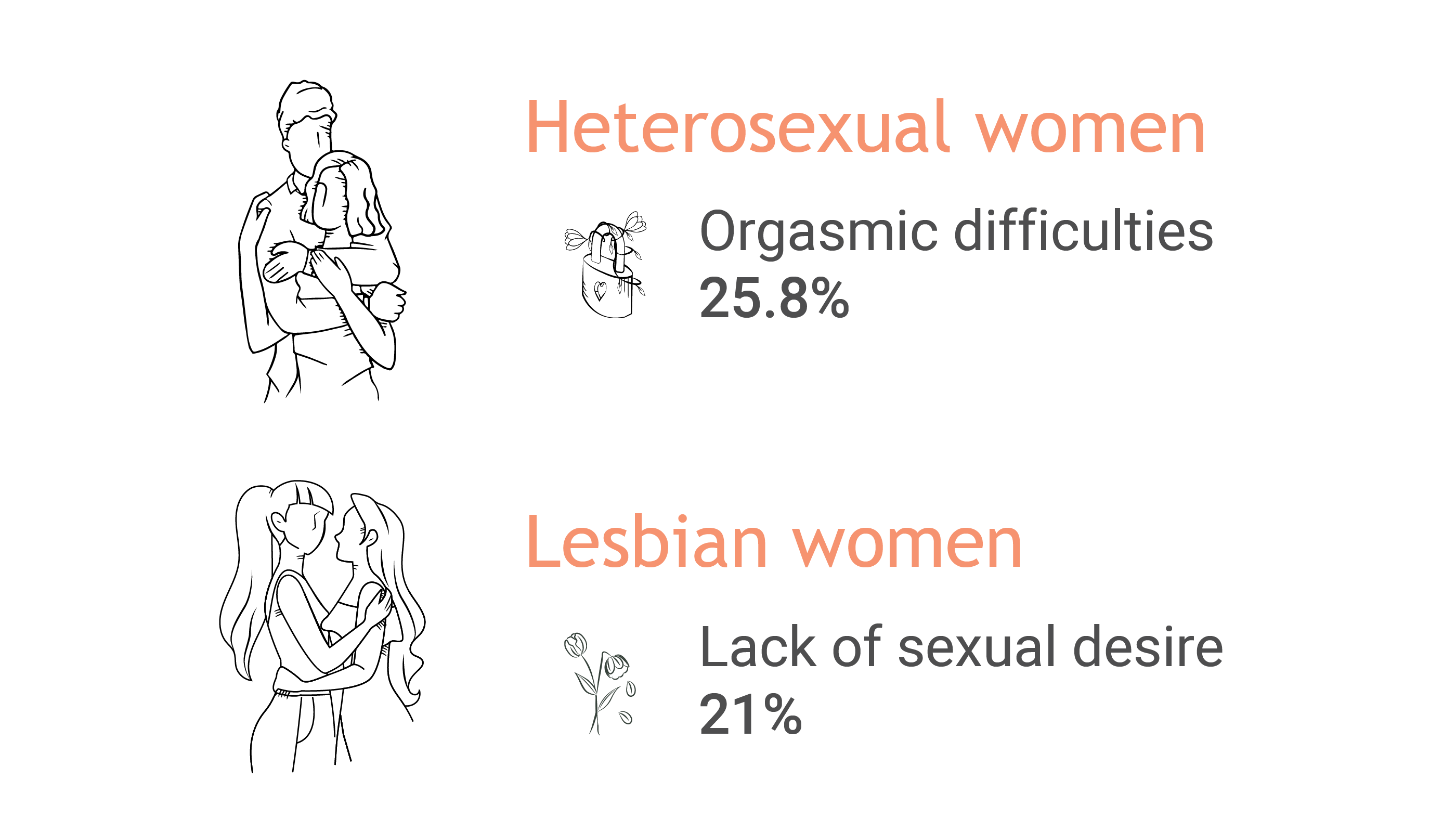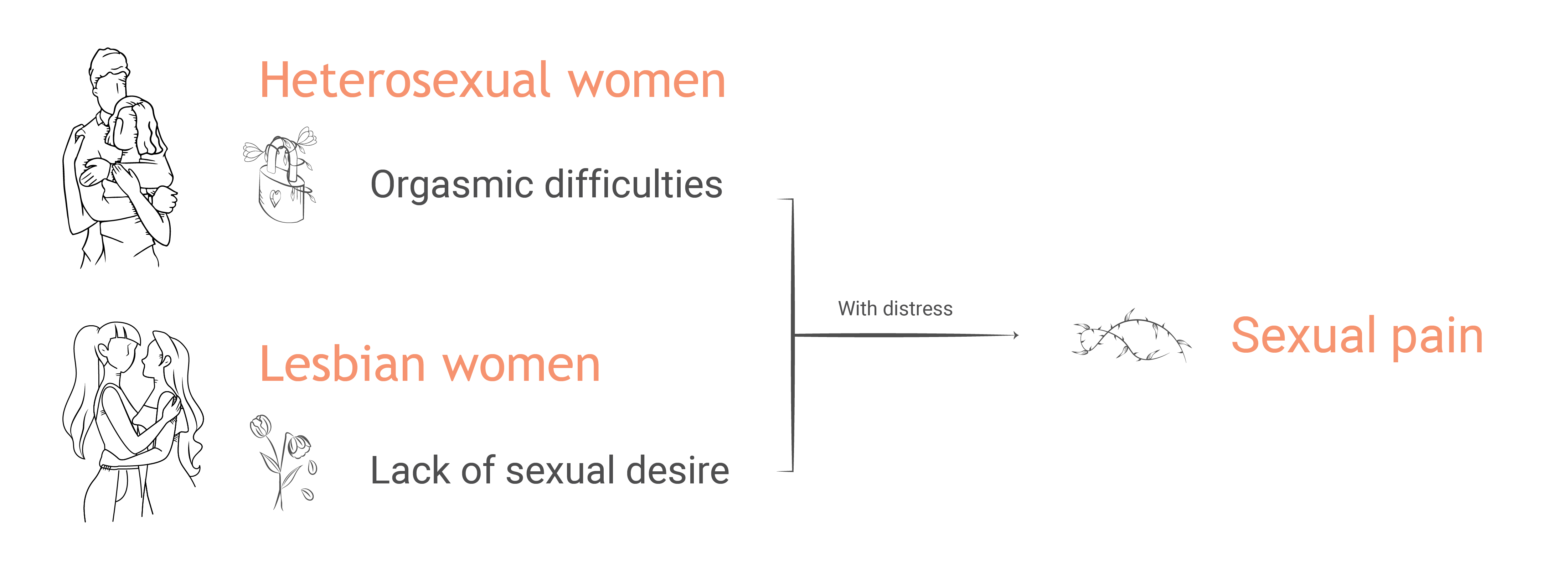Do lesbians do (or have) it better?

An insightful Portuguese study set out to address a question that may not get much attention in the field of women’s sexual health – do lesbians experience fewer sexual problems or difficulties in the realm of intimacy compared to their heterosexual counterparts?
This 2015 study pioneered a comparison of self-reported sexual problems and associated distress levels between lesbians and heterosexual women, sparking an alternative perspective on a topic usually explored through the lens of heterosexual relationships.
Methods
Over the course of a year, the researchers examined the frequency of sexual issues among 390 lesbians and 1009 heterosexual women. Participants engaged in an online questionnaire developed by the study authors to assess perceived sexual problems using a 7-point scale. The categories included orgasmic difficulties, lack of sexual desire, arousal difficulties and sexual pain. For each concern, the women were also asked to rate their level of distress.
Study participants were sourced from LGBT+ forums, websites, social networks, and universities. The two groups were matched on age, marital status, and educational level, however, the heterosexual women reported having longer relationships on average (4 years) as compared with lesbians (2.6 years).
The participants were asked to define their sexual orientation. To simplify the results, some orientations or activities (such as bisexual and pansexual women) were not included. The study also only included women who had sexual activity in the last 6 months to get a view of the problems linked to sexual activities.
What did they find?
In the last 6 months, the most frequent self-reported problems were:
The researchers then asked about distress, i.e. whether the participants were unhappy or concerned with these problems. Once the problems were linked with distress, the numbers went down in both groups and less women reported problems that caused them moderate-to-high distress.
What were the most distressing problems?
When looking at the problems that caused the most distress in women, desire was no longer in the top spot. Sexual pain was, instead, the most commonly reported and distressing sexual complaint in both groups of women. However, when looking at the problems that caused moderate or high levels of distress, lower rates of sexual problems were found in both groups of women. Meaning that often these sexual “problems” may not cause them great concern.
The study shows that the length of the relationship also plays a role, as the higher frequency of sexual problems reported by heterosexual women (especially regarding arousal, orgasmic difficulties, and sexual pain) can be partially explained by being in longer relationships as compared with lesbians. This is consistent with a number of other studies mentioned in the paper (Hassanin 2010, Ishak 2010, Sidi 2007, Stulhofer 2005).
However, the study findings showed that even after controlling for relationship length, lesbians still showed a trend of lower rates of orgasmic difficulties and sexual pain. This may be explained by their sexual behavior, which has less of a focus on vaginal penetration and more stimulation that helps their partner reach orgasm.
Overall, the study showed that both groups of women provided different answers about their sexual problems when other factors are considered, such as distress. This emphasizes the importance of assessing these factors during clinical assessment and diagnosis. In addition, a better understanding of the reasons WHY some women experience more distress than others with regards to sexual difficulties may help to improve how healthcare providers and programs can be guided to better support women.
Limitations
This study had some notable limitations, such as a demographic bias (mainly young, well-educated participants), internet access requirements (excluding women without access), and recruitment bias in the lesbian participants based on focused recruitment strategy though LGBT+ associations.
Another choice to note is that the exclusion of women who did not engage in sexual activity in the past 6 months may have led to an underestimation of the sexual problems being investigated. The study did not explore the reasons for sexual inactivity, leaving open the possibility that some participants might have abstained due to existing sexual difficulties.
And lastly, the sexual problems reported in the study were self-perceived rather than diagnosed by medical professionals, which means that the results are not completely objective. However, this is a common way of identifying sexual concerns in similar studies.
Conclusions
This study shows that both heterosexual and lesbian women face similar sexual problems, yet with some nuanced differences. When adjusting for two factors – distress and relationship length – there did not appear to be a statistically large difference between the groups. However, lower reported rates of certain sexual problems in the lesbian group may be explained by differences in sexual behavior.
These findings underscore the importance of assessing distress and providing context during clinical evaluations, inviting reflection on how healthcare providers can better support heterosexual and homosexual women dealing with intimate challenges.
Reference article:
Peixoto MM and Nobre P (2015) Prevalence of sexual problems and associated distress among lesbian and heterosexual women. J Sex Marital Ther; 41(4): 427-39.

